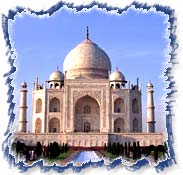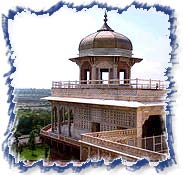Send Email Call Our Experts : 08046043349
|
Tourist Attractions Golden Triangle Tours Luxury Holidays
Cultural Tours in India
Wildlife Tours in India
 Luxury Train Tours

India Special Tours
|
|
|
Home
» Tourist Attractions »
Taj Mahal - A Tribute To Love
|
 A
three centuries old white marbled Mausoleum found India a position amongst
nations with architectural 'wonders'. What is it so regal about this ancient
monument that makes grizzled-heads sit for months trying to appropriate its
grandiose in their canvass, scribes pile volumes of outpour, tourists from
across the earth stand enamored at its sheer elegance. The Taj Mahal -
construed by Mughal Emperor Shah Jehan for his wife Mumtaz Mahal is an
eclectic assortment of Persian and Turkish motifs blended with Hindu
elements.
A
three centuries old white marbled Mausoleum found India a position amongst
nations with architectural 'wonders'. What is it so regal about this ancient
monument that makes grizzled-heads sit for months trying to appropriate its
grandiose in their canvass, scribes pile volumes of outpour, tourists from
across the earth stand enamored at its sheer elegance. The Taj Mahal -
construed by Mughal Emperor Shah Jehan for his wife Mumtaz Mahal is an
eclectic assortment of Persian and Turkish motifs blended with Hindu
elements.  Only
a stroll in the plush gardens laced around the Taj Mahal on a moonlit night
will do justice to feeling the magnanimity of what Rabindranath Tagore once
called "like a solitary tear suspended on the cheek of time". A
classic reflection of the Mughal architecture of that age, the monument is
set amidst sprawling gardens overlooking the meandering Yamuna river. The
four minarets, set symmetrically about the tomb, are scaled down to heighten
the effect of the dominant, slightly bulbous dome. Within the dome lies the
cenotaph of the queen decorated in pietra dura and the 99 different names of
Allah encrypted. As many as 35 different types of precious stones -
turquoise, jade, agate, coral, lapis Lazuli, onyx, bloodstone, cornelian,
jasper, garnet and malachite used to fashion blooms of fuchsias, lily,
honeysuckle, etc. So exquisite is the workmanship that the Taj has been
described as "having been designed by giants and finished by jewelers".
The buildings white marbled exterior responds 'with an extraordinary
subtlety to changing light and weather', giving it that aura of ethereal
aplomb. It seems bathed in a pink glow in the morning, milky white in the
evening and varnished in a tint of gold on a moonlit night.
Only
a stroll in the plush gardens laced around the Taj Mahal on a moonlit night
will do justice to feeling the magnanimity of what Rabindranath Tagore once
called "like a solitary tear suspended on the cheek of time". A
classic reflection of the Mughal architecture of that age, the monument is
set amidst sprawling gardens overlooking the meandering Yamuna river. The
four minarets, set symmetrically about the tomb, are scaled down to heighten
the effect of the dominant, slightly bulbous dome. Within the dome lies the
cenotaph of the queen decorated in pietra dura and the 99 different names of
Allah encrypted. As many as 35 different types of precious stones -
turquoise, jade, agate, coral, lapis Lazuli, onyx, bloodstone, cornelian,
jasper, garnet and malachite used to fashion blooms of fuchsias, lily,
honeysuckle, etc. So exquisite is the workmanship that the Taj has been
described as "having been designed by giants and finished by jewelers".
The buildings white marbled exterior responds 'with an extraordinary
subtlety to changing light and weather', giving it that aura of ethereal
aplomb. It seems bathed in a pink glow in the morning, milky white in the
evening and varnished in a tint of gold on a moonlit night.